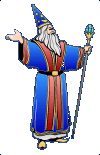- Introduction
- The study
· From the empirical analysis of the cases to the research for the
significant harmonics
· How the study was set out
· Results of the study
· Addutuibal curiosal topics
· Conclusions
Introduction:
I have the intention to reprise the interesting study that Laura Poggiani led, based upon
31 charts of violent deceases or, like in cases of disappearance, which are believed to
have followed this formality.Laura's study is based upon the ordinary distribution of
planets in signs and in houses and on traditional aspects among planets, with some
interesting look at the practice, at the analysis of midpoints and harmonics.
My task is to develop some aspects of
traditional analysis in a more organic and deeper way; to inspect the involvements
starting from the absolute harmonic aspects and the related ones to the midpoints.
Furthermore, to verify the (relative) importance of these few cases, I compared the data
of the 31 charts (from now on I will refer to them as to a "sample group") to a
control group.
The study:
Basic data:
Sample Group the research was made upon.
Data of comparison:
Checked Group (the Checked Group is different from the Sample Group because of position of
natal Moon and Mars, which are random by the Excell function = (casual()*360)+1.
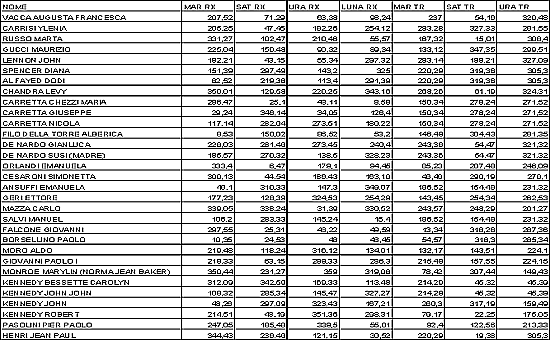
From the
empirical analysis of the cases searching for significant harmonics in the
Sample Group we examined, we saw that
Moon and Uranus tend to strongly show traditional aspects (conjunctions, oppositions,
trines, squares and sextiles) more than we expected.
The diagram below shows the number of traditional and minor aspects found inside our
Sample Group.
NAME |
URA RX
|
MOON RX
|
ANGLE
|
TYPE
|
VACCA AUGUSTA FRANCESCA
|
63,38
|
98,24
|
34,86
|
semisextile
|
CARRISI YLENIA
|
192,26
|
254,12
|
61,86
|
SEXTILE
|
RUSSO MARTA
|
210,46
|
55,57
|
154,89
|
Quinconce
|
GUCCI MAURIZIO
|
90,32
|
89,34
|
0,98
|
CONJUNCTION
|
LENNON JOHN
|
55,34
|
297,32
|
241,98
|
TRINE
|
SPENCER DIANA
|
143,2
|
325
|
181,8
|
OPPOSITION
|
AL FAYED DODI
|
113,4
|
291,39
|
177,99
|
OPPOSITION
|
CHANDRA LEVY
|
220,25
|
343,16
|
122,91
|
TRINE
|
CARRETTA CHEZZI MARIA
|
48,11
|
8,58
|
39,53
|
Novile
|
CARRETTA GIUSEPPE
|
34,05
|
126,4
|
92,35
|
SQUARE
|
CARRETTA NICOLA
|
273,51
|
180,22
|
93,29
|
SQUARE
|
FILO DELLA TORRE ALBERICA
|
86,52
|
53,2
|
33,32
|
semisextile
|
DE NARDO GIANLUCA
|
273,45
|
240,4
|
33,05
|
semisextile
|
DE NARDO SUSI (MADRE)
|
138,5
|
328,23
|
189,73
|
OPPOSITION
|
ORLANDI EMANUELA
|
179,1
|
94,45
|
84,65
|
|
CESARONI SIMONETTA
|
186,43
|
163,16
|
23,27
|
|
ANSUFFI EMANUELA
|
147,3
|
349,07
|
201,77
|
|
GERI ETTORE
|
324,53
|
254,29
|
70,24
|
|
MAZZA CARLO
|
31,39
|
330,52
|
299,13
|
|
SALVI MANUEL
|
145,24
|
16,4
|
128,84
|
TRINE
|
FALCONE GIOVANNI
|
48,22
|
49,59
|
1,37
|
CONJUNCTION
|
BORSELLINO PAOLO
|
48
|
48,45
|
0,45
|
CONJUNCTION
|
MORO ALDO
|
316,12
|
134,01
|
182,11
|
OPPOSITION
|
GIOVANNI PAOLO I
|
299,33
|
286,3
|
13,03
|
|
MONROE MARYLIN
(NORMA JEAN BAKER)
|
359
|
319,06
|
39,94
|
Novile
|
KENNEDY BESSETTE
CAROLYN
|
169,33
|
113,48
|
55,85
|
semisextile
|
KENNEDY JOHN JOHN
|
145,47
|
327,27
|
181,8
|
OPPOSITION
|
KENNEDY JOHN
|
323,43
|
167,21
|
156,22
|
|
KENNEDY ROBERT
|
351,36
|
298,31
|
53,05
|
|
PASOLINI PIER PAOLO
|
339,5
|
55,01
|
284,49
|
|
HENRI JEAN PAUL
|
121,15
|
30,52
|
90,63
|
SQUARE
|
|
|
|
|
|
SUMMARY MAJOR ASPECTS |
|
|
|
|
CONFIUNCTION
|
3
|
|
|
|
SEXTILE
|
1
|
|
|
|
SQUARE
|
3
|
|
|
|
TRINE
|
2
|
|
|
|
OPPOSITION
|
5
|
|
|
|
TOTAL
|
14
|
|
|
|
|
All traditional aspects (considering
tolerance classical orbits between aspects) are 14 out of 31 examined cases.
Here it is the same diagram compared with the Control Group (notice that in this
group the only position of the Moon was worked out again in random mode, the one of Uranus
being unchanged in radix charts.)
NAME
|
URA
RX
|
MOON RX
|
ANGLE
|
TYPE
|
VACCA AUGUSTA
FRANCESCA
|
63,38
|
301,59
|
238,53
|
TRINE
|
CARRISI YLENIA
|
192,26
|
288,29
|
96,037
|
|
RUSSO MARTA
|
210,46
|
341,58
|
131,50
|
|
GUCCI MAURIZIO
|
90,32
|
131,26
|
40,94
|
Novile
|
LENNON JOHN
|
55,34
|
18,23
|
37,10
|
Novile
|
SPENCER DIANA
|
143,2
|
226,31
|
83,11
|
Novile
|
AL FAYED DODI
|
113,4
|
40,20
|
73,19
|
|
CHANDRA LEVY
|
220,25
|
36,40
|
183,84
|
OPPOSITION
|
CARRETTA CHEZZI
MARIA
|
48,11
|
127,31
|
79,20
|
novile
|
CARRETTA
GIUSEPPE
|
34,05
|
70,35
|
36,30
|
|
CARRETTA NICOLA
|
273,51
|
101,14
|
172,36
|
|
FILO DELLA TORRE
ALBERICA
|
86,52
|
306,52
|
220,30
|
|
DE NARDO
GIANLUCA
|
273,45
|
282,69
|
9,34
|
CONJUNCTION
|
DE NARDO SUSI
(MADRE)
|
138,5
|
348,41
|
209,91
|
|
ORLANDI EMANUELA
|
179,1
|
78,73
|
100,36
|
|
CESARONI
SIMONETTA
|
186,43
|
84,42
|
102,00
|
|
ANSUFFI EMANUELA
|
147,3
|
284,09
|
136,79
|
|
GERI ETTORE
|
324,53
|
124,14
|
200,38
|
|
MAZZA CARLO
|
31,39
|
296,23
|
264,84
|
|
SALVI MANUEL
|
145,24
|
327,04
|
181,80
|
OPPOSITION
|
FALCONE GIOVANNI
|
48,22
|
160,113
|
111,89
|
|
BORSELLINO PAOLO
|
48
|
71,42
|
23,42
|
|
MORO ALDO
|
316,12
|
113,79
|
202,32
|
|
GIOVANNI PAOLO I
|
299,33
|
150,37
|
148,95
|
|
MONROE MARYLIN
|
359
|
80,51
|
278,48
|
|
KENNEDY BESSETTE CAROLYN
|
169,33
|
235,96
|
66,63
|
|
KENNEDY JOHN JOHN
|
145,47
|
118,20
|
27,26
|
semisectile
|
KENNEDY JOHN
|
323,43
|
219,47
|
103,95
|
|
KENNEDY ROBERT
|
351,36
|
80,37
|
270,98
|
SQUARE
|
PASOLINI PIER
PAOLO
|
339,5
|
128,60
|
210,89
|
|
HENRI JEAN PAUL
|
121,15
|
50,01
|
71,13
|
|
|
|
|
|
|
SUMMARY MAJOR ASPECTS
|
|
|
|
|
CONFUNCTION
|
1
|
|
|
|
SEXTILE
|
1
|
|
|
|
SQUARE
|
1
|
|
|
|
TRINE
|
1
|
|
|
|
OPPOSITION
|
2
|
|
|
|
TOTAL
|
6
|
|
|
|
|
In this case, the overall total is considerably lesser (6 compared to 14). Another feature
appearing after a little deeper exam is the presence of minor aspects, especially
semisextiles with a 30° angle. The 30° angle not only represents the typical partition
of zodiacal sectors, but also shows
at least 2 more interesting features:
· it can be considered as a "lowest common denominator" of all traditional
aspects, (multiplying this angle by 2 we get, for example, the sextile, 30 x 2 = 60, by 3
the square, 30 x 3 = 90, by 4 the trine, 30 x 4 = 120, by 6 the opposition, 30 x 6 = 180,
and by 12 the conjunction, 30 x 12 = 360).
· if we consider this aspect from the point of view of harmonics, it is equal to a 12^
harmonic.
The 12th harmonic thus stands out as one of the strongest ones inside this group of data.
In fact it picks and represents seemingly the strength of aspects connected to Uranus in
particular. In our study, though, we also kept into consideration the position of other
planets that traditional
astrology links to violent deaths, that is Mars and Saturn.
For those aspects connected to these planets, it seems interesting to examine the
influence of the 16th harmonic. The next step was to verify if those interesting results
got by reading data traditionally are confirmed by the exam of 12th harmonic. In
particular there is the reference to
Uranus’ and 16th harmonic’s aspects of every kind, both the traditionally
harmonic ones and the ones related to midpoints.
How
the study was set out:
Two harmonics have been analyzed:
· the 12th with 30° angles,
· the 16th with 22°30’ angles.
From the symbolic point of view, the explanation can be that they are
strongly stressed in the analysis of these cases.
From the symbolic point of view, the 12th harmonic can be related to the typical meanings
of 12th house, especially referring to those topics associated to the "end of the
life".
The 16th harmonic, on the other hand, can be associated to the 8th, it is child of (8 x 2
= 16) and, by symbolic association, cosignificant of the 8th house. So it is linked to
Scorpio and we noticed it often is present in cases of violent deaths.To make a simpler
description of the study, we made great use of diagrams that, in our opinion, can be read
more easily. However, to be read
properly, these diagrams have to follow two simple rules revealing if a harmonic is in
action:
1. A regular wave
2. Its width
A regular wave is meant to be one developing according to a scheme where the
concentration of higher scores (peaks) of the wave is at the beginning, in the middle and
at the end of the diagram, while the lower scores (depressions) are placed in exactly
equidistant points.
The wave width is meant as the measure of its oscillation toward the
meridian line (line of the expected results). The width tells how much this wave rises or
lowers toward the meridian line, giving information
about its strength.
To have a more accurate idea of the expected results if in the group of examined data
there were the considered harmonics, we examine here a group of three example diagrams
showing the trend of three harmonic combinations.
The first one of these harmonics we refer to as basic is a pure one and can be identified
because it tends to gather wave peaks about the first and/or the last sectors of the
diagram. Here is an example based upon the 12^ harmonic.
ecco un esempio basato sulla 12^ armonica.
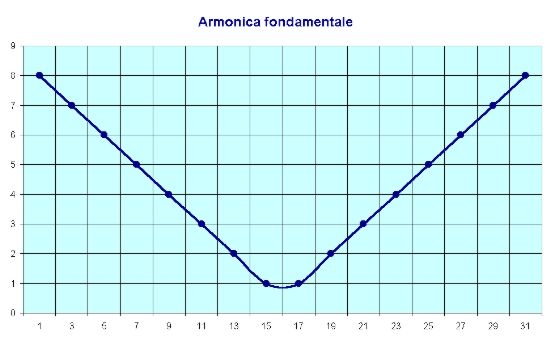
The second one of these harmonics we
refer to as the 1st level sub-harmonic derives from the basic harmonic and is equal to its
double (in the case of a 12th harmonic, it will be the 24th, 12 x 2 = 24). Peaks tend to
gather about the beginning, the middle and the end of the diagram, so that data concerning
the central peak are configured as an opposition aspect in the basic harmonic.
Here is an example based upon this 1st
level sub-harmonic.
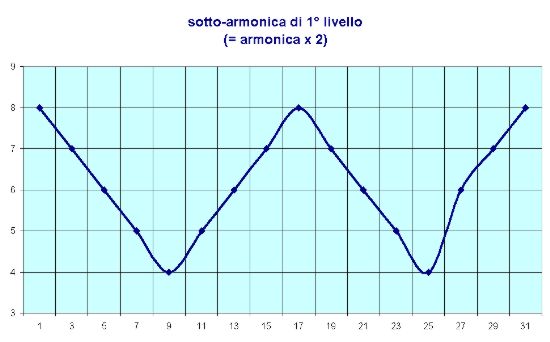
The third of these harmonics we refer to as 2nd level sub-harmonic derives from the basic
harmonic and is equal to its quadruple (in the case of the 12th harmonic, it will be the
48th, 12 x 4 = 48). Peaks tend to gather about the beginning, the middle, and at the end
of the diagram and in exactly equidistant points from them, so that the data referring to
intermediate peaks configurate as a square aspect in the basic harmonic.
Here is an example based upon this 2nd
level sub-harmonic.
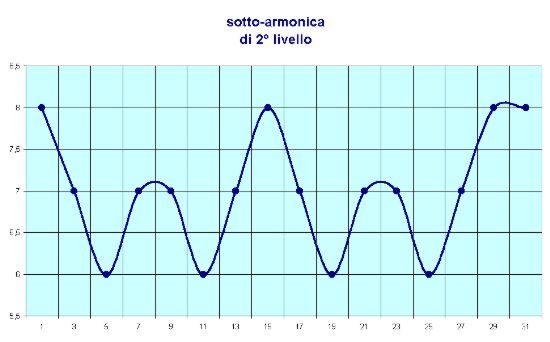
Results of the study
Since the considered data are too poor, single aspects are gathered in 2 degree sectors
(for example 0 and 1 degree are gathered in the first sector, the 2nd and the 3rd degree
are in the 3rd sector and so on).
The following are summing diagrams of aspects in 12th, the first diagram was calculated on
the base of the sample group, the second upon the control group.
Diagram showing aspects of the 12th harmonic in the Sample Group
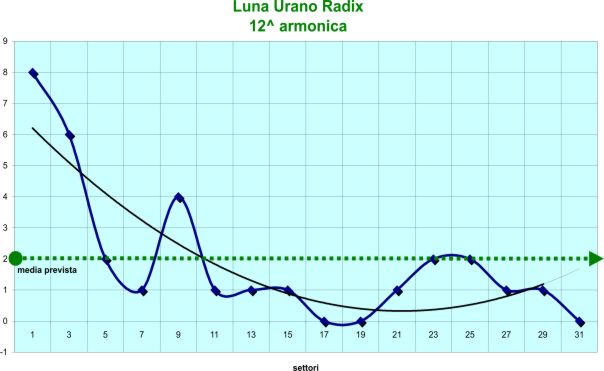
Diagram showing aspects of the 12th
harmonic in the Control Group
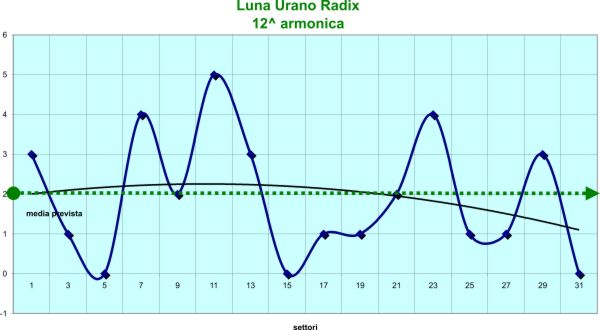
Comments about diagrams
The Sample Group diagram concentrates most of the positions about the first two sectors of
the diagram of 12th harmonic, with an outstanding pull-up (a score ranging from max 8
positions against the 2 expected ones random and 0 min), thus confirming this harmonic is
extremely strong.
The second diagram records instead the peaks which, if compared, seem quite poor (max 5,
min 0) shared out randomly.
The wave width is told by the distance of max peaks if compared to the median distance.
Are data referring to aspects Moon-Uranus confirmed also by aspects that Uranus forms with
the other two planets (Mars and Saturn)? Let's have a look at diagrams summing aspects
between all these planets.
Summing diagram of aspects of 12th
harmonics between Uranus, Moon, Mars and Saturn in the Sample Group.
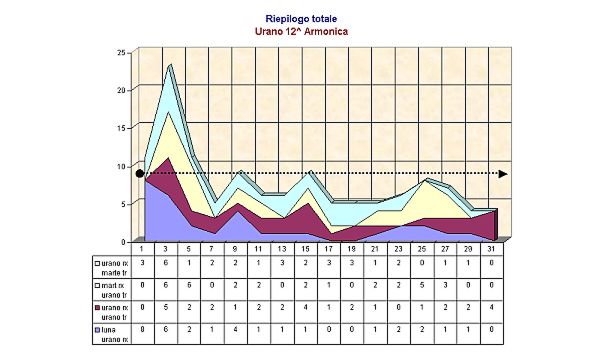
Summing diagram of aspects of 12th harmonics between Uranus, Moon, Mars and Saturn in
the Control Group.
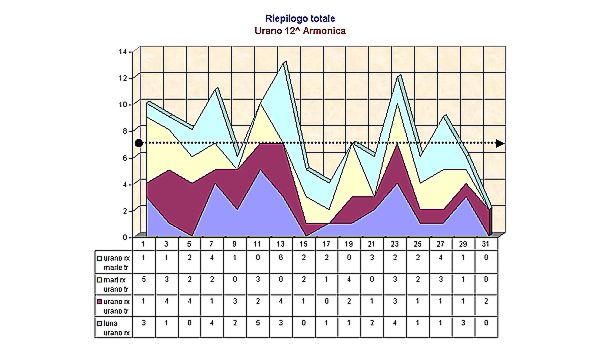
Comments to diagrams
The Sample l Group diagram, like the
former one, concentrates most of the positions about the first two sectors of the diagram
of 12th harmonic, with the wave peak raising up to 23 and decreases to 4, thus confirming
here again the outstanding strength of this harmonic.
The second diagram instead records peaks, which if compared seem to be poor again (max 14,
min 4) and, like the former one, shared out irregularly.
Now we analyze results concerning the 16th harmonic compared to aspects formed by
combining radix positions and transits of all planets, considering the absolute positions
and midpoints they form.
This harmonic, bringing back to the 8th of which it is child (8 x 2 = 16),as we can see,
is symbolically linked to the Sign of Scorpio and to the 8th House.
To tell the study in a simpler way, we gathered in the same diagram all the relationships
between Moon, Mars, Saturn, and Uranus, seeking those two simple rules revealing if there
is an harmonic.
1. the regularity of the wave
2. its width
The first diagram shows the results concerning the Sample Group, the second one the ones
concerning the Control Group.
Sample Group Diagram
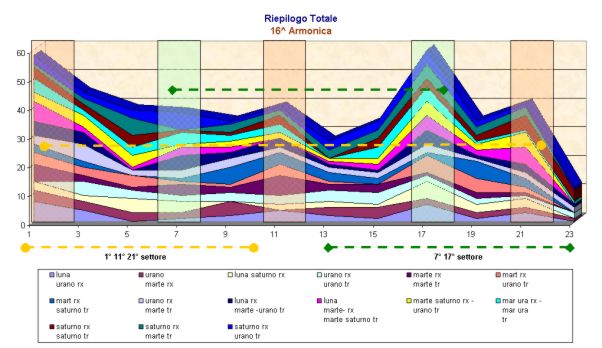
Control Group Diagram
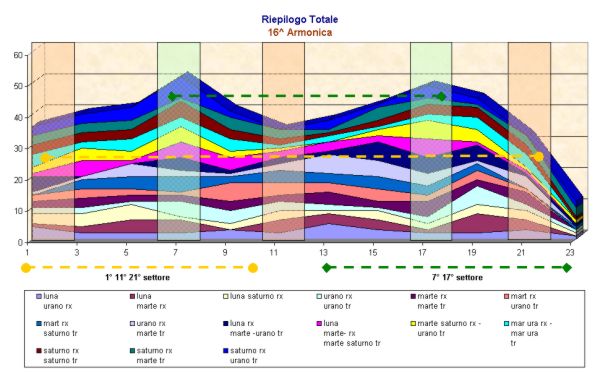
If we compare 16th harmonic diagrams, we can see how the sample group diagram shows
a regularity and a wave width (rising up to a value of 60 and falling, on the
average, to about 30, with an oscillation of 30 points) absolutely adapted to the theory
of harmonics. This theory says that peaks and depressions follow each other regularly, the
peaks concentrating at the beginning, in the middle and at the end of the diagram, the
depressions in exactly equidistant points.
The check diagram instead shows an absolutely irregular trend (see the highlit parts) and
a width ranging between 35 and 50 (with a 15 point difference). This width is exactly half
the one of Sample Group.
However, these diagrams show a more even distribution of aspects with peaks concentrating
mostly at the beginning of the diagram and about the 17th sector. This is true if we
compare these diagrams to those of the 12th harmonic, which are related to Uranus, in
which there is a strong basic harmonic.
This trend is typical of a sub-harmonic of the 16th, in this case the 64th (8 x 8 or 16 x
4).
In other words aspects concentrating around the 17th sector are equivalent to square
aspects in the 16th harmonic, and become conjunctions in the 64th harmonic.
Another important consideration is about the fact that results are equal, although
examined aspects are extremely different: in fact not only traditional aspects (radix and
transit) between planets are considered, but also some techniques combining absolute
positions and middle points (see diagram keys). This seems to suggest that planets
strength is conditioned by the sum of micro-aspects which form according to an identical
harmonic basic frequency (in this case the 64th).
Additional
unusual topics
Some relationships between Moon and
Uranus seemed particularly interesting. The most "speaking" aspects are the ones
related to the two heroes of the so-called "Sicily springtime", Giovanni
Falcone and Paolo Borsellino.
NAME |
URANUS
Radix |
MOON
Radix |
ANGLE |
TYPE |
FALCONE
GIOVANNI |
48,22 |
49,59 |
1,37 |
CONJUNCTION |
BORSELLINO
PAOLO |
48 |
48,45 |
0,45 |
CONJUNCTION |
|
Both of them show a very tight
Moon-Uranus conjunction about the same degrees of Taurus.
The Moon-Uranus relationships of Lady Diana and Dodi Al Fayed are "speaking" as
well:
NAME |
URANUS
Radic |
MOON
Radix |
ANGLE |
TYPE |
SPENCER DIANA |
143,2 |
325 |
181,8 |
OPPOSITION |
AL FAYED DODI |
113,4 |
291,39 |
177,99 |
OPPOSITION |
|
Both of them show an opposition at birth
between Moon and Uranus, but the two Uranus are in a very tight semisextile aspect and
they can be brought back to the 12th harmonic.
NAME |
URANUS
Radix |
MOON
Radix |
ANGLE |
TYPE |
CARRETTA
GIUSEPPE |
34,05 |
126,4 |
92,35 |
SQUARE |
CARRETTA NICOLA |
273,51 |
180,22 |
93,29 |
SQUARE |
|
Finally we consider Carettas, showing a square relationship between the Moon and Uranus
positions, and also in this case the 90 degree aspect can be brought back to a 12th
harmonic (30° x 3 = 90°).
Conclusions:
Although these data are very poor in
numbers, they highlight some interesting elements. if these elements are confirmed by
further analysis, they can build the track of a system which can find particular positions
and/or potentially negative planet combinations of birth and transiting. They can also be
taken into consideration to tackle with them in an effecitve way, acting in a
"active" conception of astrology.
Trans. by Carmen
Santarpino - All Rights Reserved |
